Light imitates art
View Sequence overviewStudents will:
- identify primary sources of light.
- explain how light helps people to see.
- identify that light travels in a straight line.
Students will represent their understanding as they:
- create a data table naming and explaining sources of light.
- categorise sources of light as natural and man-made.
- use arrows to identify the path that light travels.
In this lesson, assessment is formative.
Feedback might focus on:
- students’ identification and categorisation of sources of light. Are they able to identify sources of light? Can they differentiate between natural and man-made light, or light that is being transferred vs another form of energy being transformed into light energy?
- students’ descriptions of how light helps us to see. Have students identified that light comes from a source outside the box to illuminate inside the box? Have they identified that light needs to reach the eye for them to see? Have they identified that light bounces off an object before travelling to the eye?
- students' ray diagrams. Have they used straight lines and arrows to show the direction light was moving? Do they show the light rays bouncing off objects and thus changing direction?
Whole class
Class science journal (digital or hard-copy)
Materials to add to a word wall or class glossary
Demonstration copy of Sources of light Resource sheet (or create your own)
Shoe box or similar to create a demonstration peek box, or use the one created in lesson 1
Each group
Shoe box or similar to create a peek box
Scissors
An object small enough to place inside the peek box
Tape/Blu-tac to secure the item in place
A torch
Each student
Individual science journal (digital or hard-copy)
Sources of light Resource sheet (or create their own)
SAFETY NOTE: Remind students never to look directly at a source of light, or intentionally shine a light into the eyes of others. This includes torches, the Sun, and laser pointers. Looking directly at sources of bright light can cause permanent and irreversible eye damage.
Lesson
Re-orient
Review student responses to the question “What things give us light?” from Lesson 1.
The Inquire phase allows students to cycle progressively and with increasing complexity through the key science ideas related to the core concepts. Each Inquire cycle is divided into three teaching and learning routines that allow students to systematically build their knowledge and skills in science and incorporate this into their current understanding of the world.
When designing a teaching sequence, it is important to consider the knowledge and skills that students will need in the final Act phase. Consider what the students already know and identify the steps that need to be taken to reach the level required. How could you facilitate students’ understanding at each step? What investigations could be designed to build the skills at each step?
Read more about using the LIA FrameworkIdentifying and constructing questions is the creative driver of the inquiry process. It allows students to explore what they know and how they know it. During the Inquire phase of the LIA Framework, the Question routine allows for past activities to be reviewed and to set the scene for the investigation that students will undertake. The use of effective questioning techniques can influence students’ view and interpretation of upcoming content, open them to exploration and link to their current interests and science capital.
When designing a teaching sequence, it is important to spend some time considering the mindset of students at the start of each Inquire phase. What do you want students to be thinking about, what do they already know and what is the best way for them to approach the task? What might tap into their curiosity?
Read more about using the LIA FrameworkHow do we see light?
Pose the question: How do we see light?
Discuss what happens if we shut our eyes.
Potential discussion prompts
- What do we see when we shut our eyes? Can you see light? Or colour?
- What do we see if we are blindfolded?
- What do we need our eyes for?
- What can we see if our eyes are open but there is no light?
- What do we mean when we use the word 'light'? Can it refer to more than one thing?
- The word 'light' might be used to describe the source, or things that emit light (turn the light on), the effects (the light is shining on the wall) or as a scientific concept where light is an entity that can travel.
- Students might also identify other uses of the word 'light', for example as an opposite to heavy, or as a description in relation to colour.
Pose the question: What are sources of light? How might sources of light be categorised?
The Inquire phase allows students to cycle progressively and with increasing complexity through the key science ideas related to the core concepts. Each Inquire cycle is divided into three teaching and learning routines that allow students to systematically build their knowledge and skills in science and incorporate this into their current understanding of the world.
When designing a teaching sequence, it is important to consider the knowledge and skills that students will need in the final Act phase. Consider what the students already know and identify the steps that need to be taken to reach the level required. How could you facilitate students’ understanding at each step? What investigations could be designed to build the skills at each step?
Read more about using the LIA FrameworkThe Investigate routine provides students with an opportunity to explore the key ideas of science, to plan and conduct an investigation, and to gather and record data. The investigations are designed to systematically develop content knowledge and skills through increasingly complex processes of structured inquiry, guided inquiry and open inquiry approaches. Students are encouraged to process data to identify trends and patterns and link them to the real-world context of the teaching sequence.
When designing a teaching sequence, consider the diagnostic assessment (Launch phase) that identified the alternative conceptions that students held. Are there activities that challenge these ideas and provide openings for discussion? What content knowledge and skills do students need to be able to complete the final (Act phase) task? How could you systematically build these through the investigation routines? Are there opportunities to build students’ understanding and skills in the science inquiry processes through the successive investigations?
Read more about using the LIA FrameworkWhat things give us light?
Students work in collaborative teams to identify and record sources of light on the Sources of light Resource sheet, as well as three ideas they have about that source of light. They may use examples identified in Lesson 1 or add new ideas to the list. Remind students that, in this instance, we are using the term ‘light’ in terms of things that allow/introduce light into a space or area.
Brainstorm the types of things students might write about in the ideas column, modelling an example to show how they might complete the investigation. See the sample table below for ideas.
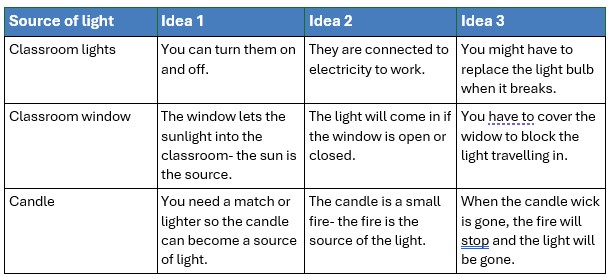
Alternative conceptions—sources of light and how light helps us see
What alternative conceptions might students hold and how does this lesson address them?

Many alternative conceptions of light are centred around the different ways we use the word light. It can be used to describe the source, or things that emit light (turn the light on), the effects (the light is shining on the wall) or as a science concept where light is an entity that can travel. This can be directly addressed when unpacking the different uses of the word 'light'.
When representing the movement of light, many students will draw small lines emerging from a light source, such as a torch or the Sun. These lines are usually short, straight and point in all directions.
Light does travel in approximately straight lines but does not stop a short distance from the source unless interrupted by matter. Depending on the nature of the source, the light might travel in multiple directions, or it might be focused.
A common alternative conception held by students is that light travels to the eye first and then from the eye to an object. Alternatively, students may suggest that their eyes are the source of light (laser beams as illustrated in cartoons).
In actuality, light is reflected off objects towards our eyes. Our eyes see/record the reflected light. The first step in addressing this alternative conception is encouraging students to identify the source of the light.
A ‘ray diagram’ uses the drawing of these ‘light rays’ to explain light behaviour, such as:
- the path which light takes from a light source to our eyes.
- the way light is blocked by opaque objects, reflected from objects, transmitted through transparent objects, or ‘bent’ due to large gravitational forces.
- when light passes from one material to another, for example, from air into water.
These 'light rays' are represented using arrows, as is the common scientific convention for representing the movement of energy. Students will have encountered this when learning about heat in Year 3.
Some students might think that light is not considered to ‘travel’; rather it is thought to just exist in space. Students might also think that light from weak sources doesn’t travel as far as light from strong sources. In fact, all light travels from its source in all directions, regardless of its intensity, unless interrupted by matter, such as air, water or an object, where it is reflected, transmitted or absorbed.
Students demonstrating a high level of understanding may show that light actually travels from the globe in all directions and bounces off all surfaces and objects around it.
These alternative conceptions will be addressed during the peek-box activity, where students will observe that it is the light bouncing of an object that allows us to see it, and then represent and discuss this representation during the gallery walk.
Many alternative conceptions of light are centred around the different ways we use the word light. It can be used to describe the source, or things that emit light (turn the light on), the effects (the light is shining on the wall) or as a science concept where light is an entity that can travel. This can be directly addressed when unpacking the different uses of the word 'light'.
When representing the movement of light, many students will draw small lines emerging from a light source, such as a torch or the Sun. These lines are usually short, straight and point in all directions.
Light does travel in approximately straight lines but does not stop a short distance from the source unless interrupted by matter. Depending on the nature of the source, the light might travel in multiple directions, or it might be focused.
A common alternative conception held by students is that light travels to the eye first and then from the eye to an object. Alternatively, students may suggest that their eyes are the source of light (laser beams as illustrated in cartoons).
In actuality, light is reflected off objects towards our eyes. Our eyes see/record the reflected light. The first step in addressing this alternative conception is encouraging students to identify the source of the light.
A ‘ray diagram’ uses the drawing of these ‘light rays’ to explain light behaviour, such as:
- the path which light takes from a light source to our eyes.
- the way light is blocked by opaque objects, reflected from objects, transmitted through transparent objects, or ‘bent’ due to large gravitational forces.
- when light passes from one material to another, for example, from air into water.
These 'light rays' are represented using arrows, as is the common scientific convention for representing the movement of energy. Students will have encountered this when learning about heat in Year 3.
Some students might think that light is not considered to ‘travel’; rather it is thought to just exist in space. Students might also think that light from weak sources doesn’t travel as far as light from strong sources. In fact, all light travels from its source in all directions, regardless of its intensity, unless interrupted by matter, such as air, water or an object, where it is reflected, transmitted or absorbed.
Students demonstrating a high level of understanding may show that light actually travels from the globe in all directions and bounces off all surfaces and objects around it.
These alternative conceptions will be addressed during the peek-box activity, where students will observe that it is the light bouncing of an object that allows us to see it, and then represent and discuss this representation during the gallery walk.
The Inquire phase allows students to cycle progressively and with increasing complexity through the key science ideas related to the core concepts. Each Inquire cycle is divided into three teaching and learning routines that allow students to systematically build their knowledge and skills in science and incorporate this into their current understanding of the world.
When designing a teaching sequence, it is important to consider the knowledge and skills that students will need in the final Act phase. Consider what the students already know and identify the steps that need to be taken to reach the level required. How could you facilitate students’ understanding at each step? What investigations could be designed to build the skills at each step?
Read more about using the LIA FrameworkFollowing an investigation, the Integrate routine provides time and space for data to be evaluated and insights to be synthesized. It reveals new insights, consolidates and refines representations, generalises context and broadens students’ perspectives. It allows student thinking to become visible and opens formative feedback opportunities. It may also lead to further questions being asked, allowing the Inquire phase to start again.
When designing a teaching sequence, consider the diagnostic assessment that was undertaken during the Launch phase. Consider if alternative conceptions could be used as a jumping off point to discussions. How could students represent their learning in a way that would support formative feedback opportunities? Could small summative assessment occur at different stages in the teaching sequence?
Read more about using the LIA FrameworkCategorising sources of light
Students share the sources of light they identified and the ideas they had about each one. Discuss and record each source of light and related ideas in the class science journal using a demonstration copy of the Sources of light resource sheet.
Create a mind map in the class science journal with sources of light in the centre, and two branches, one titled ‘natural’ and the other ‘artificial’. Discuss the terms, noting that artificial light involves human manipulation in some form. As a class, categorise the sources of light as natural or artificial, recording each source on the mind-map with any relevant accompanying notes.
Discuss how fire could be considered both natural, because it can occur on its own due to natural processes, and artificial, because humans have learned to used specific resources to create fire when they want/need to.
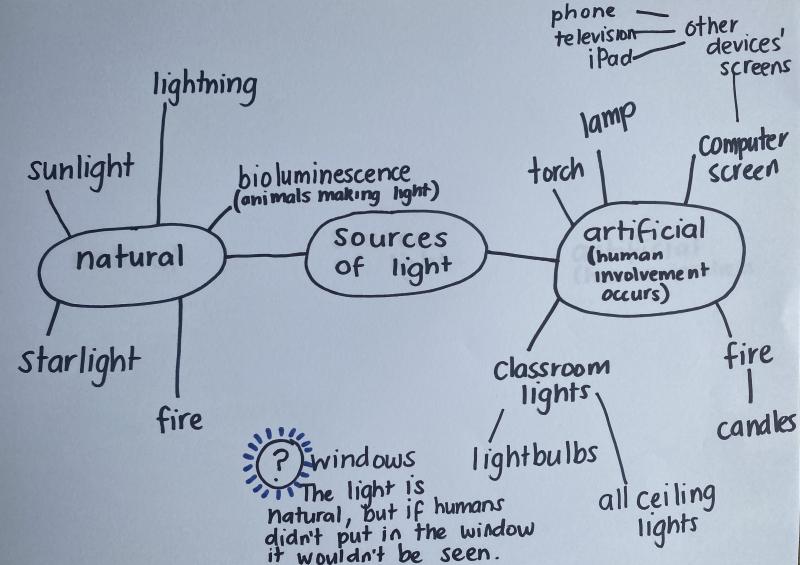
Discuss what students think about the origin of the sources of light.
- Where do you think the object/source is 'getting its light from'?
- Does the object source emit its own light, or is the light coming from somewhere else?
- Does the object/source constantly provide light? Can it be switched off or otherwise made to not emit light?
- Would it still be a source of light if all other sources were switched off or blocked out?
- Could it be a source in the middle of the night?
- Is the Moon a source of light?
- Is the Moon a source of light in the middle of the day?
- Does the Moon emit its own light?
- The Moon does 'provide' light when it is dark, but it is not the source of that light. The source of the Moon's light is the Sun. When the Moon can be seen at night, the Sun is on the opposite side of Earth. The Sun’s rays are reflected off the surface of the Moon, illuminating it and providing some light at night.
- Does the Moon always produce the same amount of light? (New moon vs full moon.)
- The position of the moon relative to the Earth and Sun affects how much light can reflect of it. That's why the Moon appears as different shapes/sizes in the sky.
- A full moon occurs when the largest surface area of the Moon is facing the Sun, and therefore reflecting sunlight off a larger surface. The size of the Moon's surface area lessens each day as the positions of the Sun, Earth and Moon change. This is what causes the appearance of crescent, quarter, gibbous and new moons. A new moon occurs when there is not surface area of the Moon facing the Sun, so it cannot reflect its rays.
- NOTE: Students will have explored concepts relating to day and night in Year 2, and will encounter it again in Year 6. It is not necessary at this stage for them to have a full understanding of the relative position of the Sun, Earth and Moon, or the Moon's phases. They simply need to be aware that the Moon is not actually a source of light.
Optional: Categorise the sources of light in other ways, for example, sources where light is its primary purpose, such as a lamp, or light bulb, and sources where light is produced as a secondary outcome, such as a toaster.
Optional: Discuss how light is often accompanied by heat. Students will have learned concepts related to heat energy in Year 3. Introduce that idea that both heat and light are forms of energy. Discuss what students know about energy. This will be revisited later in the lesson, and again in Lesson 4.
Sources of light
How might students categorise sources of light?
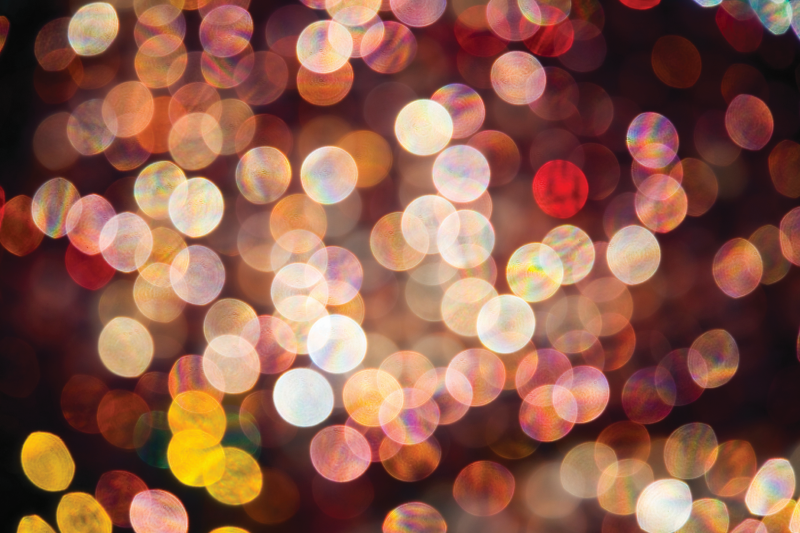
Students will likely identify natural and artificial sources of light, for example the Sun, and a light bulb or lamp. They might also identify objects where light is produced as a secondary function or by-product of another function, for example: a toaster, a television, or a computer.
Students will be able to identify a greater variety of sources of light as they are exposed to other students’ ideas.
Light is a form of energy, and as such it cannot be created or destroyed. Energy is either transferred or transformed. The sources of light that students identify will either represent:
- energy that is being transferred—for example the moon reflecting the sun's light, or a mirror that helps bounce light around the room.
- energy that is being transformed—for example electrical energy being converted in a light bulb, chemical energy being transformed into fire.
Understanding many of these examples requires an understanding of other scientific phenomena that students may have encountered, but not fully grasp at this year level. For example, the concept that the moon is not a source of light, but a reflection of the Sun's light, requires an understanding of the relative positions of the Sun, Earth and moon and how they cause day and night. Students will have encountered this in Year 2, but will not explore it in greater detail until Year 6.
Another example is the concept of electrical energy being transformed into light energy, and incidentally heat energy (as some heat is typically emitted with light energy). Students will have explored the transfer (only) of heat energy in Year 3 but will not learn about the transformation of electrical energy until Year 6.
This sequence provides an opportunity to lay the groundwork for students to begin connecting important scientific ideas across science disciplines.
Students will likely identify natural and artificial sources of light, for example the Sun, and a light bulb or lamp. They might also identify objects where light is produced as a secondary function or by-product of another function, for example: a toaster, a television, or a computer.
Students will be able to identify a greater variety of sources of light as they are exposed to other students’ ideas.
Light is a form of energy, and as such it cannot be created or destroyed. Energy is either transferred or transformed. The sources of light that students identify will either represent:
- energy that is being transferred—for example the moon reflecting the sun's light, or a mirror that helps bounce light around the room.
- energy that is being transformed—for example electrical energy being converted in a light bulb, chemical energy being transformed into fire.
Understanding many of these examples requires an understanding of other scientific phenomena that students may have encountered, but not fully grasp at this year level. For example, the concept that the moon is not a source of light, but a reflection of the Sun's light, requires an understanding of the relative positions of the Sun, Earth and moon and how they cause day and night. Students will have encountered this in Year 2, but will not explore it in greater detail until Year 6.
Another example is the concept of electrical energy being transformed into light energy, and incidentally heat energy (as some heat is typically emitted with light energy). Students will have explored the transfer (only) of heat energy in Year 3 but will not learn about the transformation of electrical energy until Year 6.
This sequence provides an opportunity to lay the groundwork for students to begin connecting important scientific ideas across science disciplines.
The Inquire phase allows students to cycle progressively and with increasing complexity through the key science ideas related to the core concepts. Each Inquire cycle is divided into three teaching and learning routines that allow students to systematically build their knowledge and skills in science and incorporate this into their current understanding of the world.
When designing a teaching sequence, it is important to consider the knowledge and skills that students will need in the final Act phase. Consider what the students already know and identify the steps that need to be taken to reach the level required. How could you facilitate students’ understanding at each step? What investigations could be designed to build the skills at each step?
Read more about using the LIA FrameworkIdentifying and constructing questions is the creative driver of the inquiry process. It allows students to explore what they know and how they know it. During the Inquire phase of the LIA Framework, the Question routine allows for past activities to be reviewed and to set the scene for the investigation that students will undertake. The use of effective questioning techniques can influence students’ view and interpretation of upcoming content, open them to exploration and link to their current interests and science capital.
When designing a teaching sequence, it is important to spend some time considering the mindset of students at the start of each Inquire phase. What do you want students to be thinking about, what do they already know and what is the best way for them to approach the task? What might tap into their curiosity?
Read more about using the LIA FrameworkHow do I see it?
Explain to students that now they have identified some sources of light, they are going to investigate how light helps us to see. Referring to any similar student questions asked during Lesson 1, pose the question: How does light help us to see?
The Inquire phase allows students to cycle progressively and with increasing complexity through the key science ideas related to the core concepts. Each Inquire cycle is divided into three teaching and learning routines that allow students to systematically build their knowledge and skills in science and incorporate this into their current understanding of the world.
When designing a teaching sequence, it is important to consider the knowledge and skills that students will need in the final Act phase. Consider what the students already know and identify the steps that need to be taken to reach the level required. How could you facilitate students’ understanding at each step? What investigations could be designed to build the skills at each step?
Read more about using the LIA FrameworkThe Investigate routine provides students with an opportunity to explore the key ideas of science, to plan and conduct an investigation, and to gather and record data. The investigations are designed to systematically develop content knowledge and skills through increasingly complex processes of structured inquiry, guided inquiry and open inquiry approaches. Students are encouraged to process data to identify trends and patterns and link them to the real-world context of the teaching sequence.
When designing a teaching sequence, consider the diagnostic assessment (Launch phase) that identified the alternative conceptions that students held. Are there activities that challenge these ideas and provide openings for discussion? What content knowledge and skills do students need to be able to complete the final (Act phase) task? How could you systematically build these through the investigation routines? Are there opportunities to build students’ understanding and skills in the science inquiry processes through the successive investigations?
Read more about using the LIA FrameworkThe path of light
If the peek box was used in Lesson 1, reintroduce it and ask students what to recall when they looked into the viewing window: they could not see any of the objects inside of it until the ‘side door’ was created and light was shone through it.
If the peek box was not used in Lesson 1, introduce a partially completed peek box (with a viewing hole, but no light window) and ask students to predict what they will see when they look in through the viewing hole.
Allow students the opportunity to look into the viewing hole to see if they can see anything inside the box, and describe how well they can see it.
- Do you think you will be able to see an object that is inside this box? Why? Why not?
- What might you do to be able to see it better?
- What might you do to see the object better if you could not remove the lid?
Students work in teams to create their own peek boxes containing an item of their choosing, exploring how peek boxes work and how they might alter the box to be able to see the object inside without removing the lid.
To be able to see the object, students will need to create a hole or ‘light window’ to introduce light into the box. Shining a torch through this light window will illuminate the object inside the box, showing students that it is the light reflecting off the object that helps them to see it.
Discuss:
- where the light window might be placed for best results e,g. directly beside or above the object they're trying to see, so the most light will reach it.
- why it would be unsafe to place the light window directly behind the object—this would cause the light from the torch to shine directly into students’ eyes, which is unsafe and can cause eye damage.
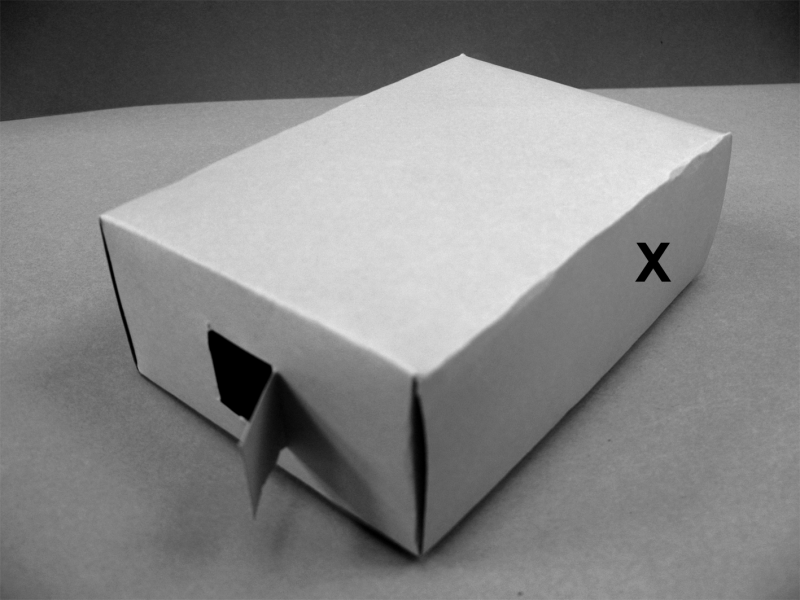
After creating their peek box in teams, students individually draw a diagram to represent what they did to the box to get light to shine into it. The diagrams should include the source of light and where it is coming from and moving to.
Undertake a gallery walk to share/discuss what students have drawn to show the path of the light from its source to help them to see the object inside the box.
It is likely that some students will use arrows to show the direction they think the light is traveling. Draw attention to this and discuss why they have used lines. Once the use of lines to show the path of light has been established, focus on any diagrams that use arrow heads on those lines to show the direction of light, and establish why this is helpful.
If students have not used arrow heads, then ask if they think the inclusion of arrow heads would be helpful for this diagram and why.
- Which diagrams showed the movement of light the most clearly?
- Why do you think that?
- Why do you think arrows can be helpful to show the movement of light?
Modelling and representation—ray diagrams
What is a ray diagram and why should students use them?
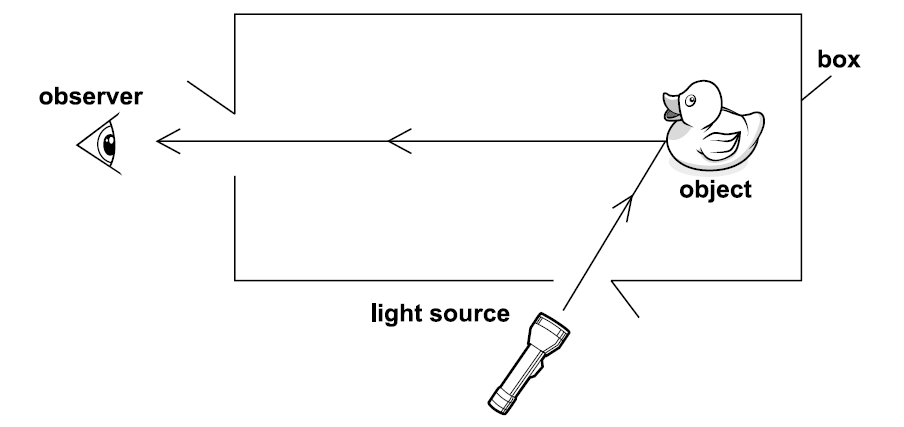
A ray diagram is a type of scientific model used by scientists to show the possible paths light takes as it spreads out, or is transferred, from its source into the surrounding area. Lines are used to show light travelling. The lines are straight because light travels in a straight line over short distances. Arrowheads show the direction of travel.
The purpose of this activity and discussion is to develop a ray diagram model in context. By doing so students are more likely to understand the reasoning behind the model and how it represents the movement of light.
It is likely that students will draw lines showing the light coming from the torch, with the arrow heads pointed toward the object in the box. Students may be confused about where the light travels after reaching the object.
Most accurately, the light from the torch spreads out in all directions, travelling in a straight line until it hits an object and bounces off it in another direction. For the purposes of this drawing, it is important to focus only on how the light travels towards the object in the box and bounces off it towards the person’s eye so that it can be seen.
Ray diagrams are also important because they follow the standard scientific conventions of using arrows to represent the movement, direction and magnitude of energy transfer. Students will have encountered this convention in Year 3 when drawing diagrams to represent the movement of heat, and in Year 4 when drawing diagrams to represent the movement of energy in a food chain. They will encounter it again in Year 6 when representing the flow of electrical energy in a circuit.
A ray diagram is a type of scientific model used by scientists to show the possible paths light takes as it spreads out, or is transferred, from its source into the surrounding area. Lines are used to show light travelling. The lines are straight because light travels in a straight line over short distances. Arrowheads show the direction of travel.
The purpose of this activity and discussion is to develop a ray diagram model in context. By doing so students are more likely to understand the reasoning behind the model and how it represents the movement of light.
It is likely that students will draw lines showing the light coming from the torch, with the arrow heads pointed toward the object in the box. Students may be confused about where the light travels after reaching the object.
Most accurately, the light from the torch spreads out in all directions, travelling in a straight line until it hits an object and bounces off it in another direction. For the purposes of this drawing, it is important to focus only on how the light travels towards the object in the box and bounces off it towards the person’s eye so that it can be seen.
Ray diagrams are also important because they follow the standard scientific conventions of using arrows to represent the movement, direction and magnitude of energy transfer. Students will have encountered this convention in Year 3 when drawing diagrams to represent the movement of heat, and in Year 4 when drawing diagrams to represent the movement of energy in a food chain. They will encounter it again in Year 6 when representing the flow of electrical energy in a circuit.
The Inquire phase allows students to cycle progressively and with increasing complexity through the key science ideas related to the core concepts. Each Inquire cycle is divided into three teaching and learning routines that allow students to systematically build their knowledge and skills in science and incorporate this into their current understanding of the world.
When designing a teaching sequence, it is important to consider the knowledge and skills that students will need in the final Act phase. Consider what the students already know and identify the steps that need to be taken to reach the level required. How could you facilitate students’ understanding at each step? What investigations could be designed to build the skills at each step?
Read more about using the LIA FrameworkFollowing an investigation, the Integrate routine provides time and space for data to be evaluated and insights to be synthesized. It reveals new insights, consolidates and refines representations, generalises context and broadens students’ perspectives. It allows student thinking to become visible and opens formative feedback opportunities. It may also lead to further questions being asked, allowing the Inquire phase to start again.
When designing a teaching sequence, consider the diagnostic assessment that was undertaken during the Launch phase. Consider if alternative conceptions could be used as a jumping off point to discussions. How could students represent their learning in a way that would support formative feedback opportunities? Could small summative assessment occur at different stages in the teaching sequence?
Read more about using the LIA FrameworkBuilding a shared understanding
Display a pre-prepared, incomplete diagram showing a peek box with its viewing window, light window and an object inside.
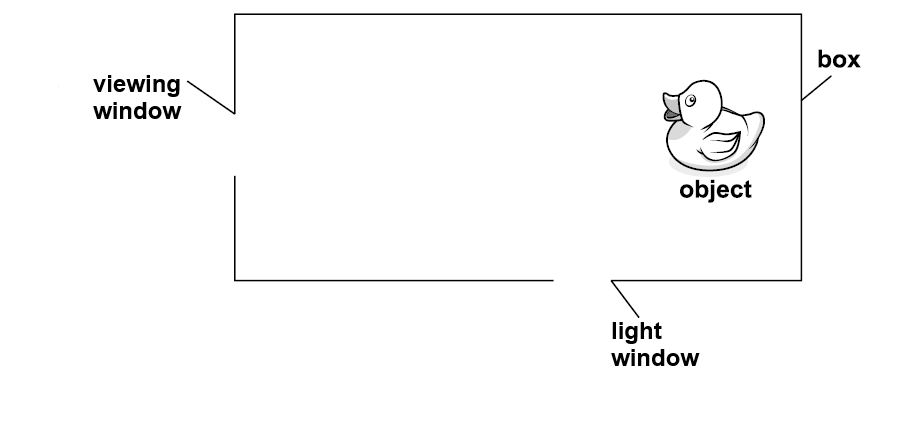
Through questioning and discussion, determine that the light travels from the torch to the object in the box, then ‘bounces’ off this object towards the viewing window, allowing the object to be seen by the viewer. You could also hold this discussion as part of the gallery walk.
- When the peek box only had a viewing window, could you see the object inside the box?
- Was it easy or difficult to see the object? Could you see the colours or the design on the object?
- Why do you think that was happening?
- Did adding the light window to the peek box make it easier to see the colours or the designs on the object inside (before you shone the torch in through the light window)?
- Why/why not?
- What extra details could you see on the object inside the peek box better once you shone the torch in through the light window?
- Where was the light traveling to?
- It shone on the object inside the box.
- How do you know that?
- The object was lit up really brightly. The light window was at the end of the box where we placed the object.
- Did the light get to your eye?
- Yes, but it wasn’t shining at our eye directly, but shining on the object, and bouncing off that object to our eyes.
- How did the light help you see the object?
- How could we show where the light came from and where it went?
- We used arrows.
Once consensus has been reached that the light travelled towards the object, then bounced off it and towards our eyes so it could be seen, complete the drawing in the class science journal. Emphasise the use of the arrow heads to accurately show the paths of the light.

Introduce the term ‘ray diagram’ and discuss what they are used for: to show the path and direction that light is travelling.
Students then generalise their understanding (thus deepening it) by drawing a ray diagram to represent how light moves to help us to see other objects, for example how they can see objects lit up by the sun, or by lights in a room.
Ask students what other word they might use to describe the way that light moves when it reaches an object, other than ‘bounces off’. If required introduce the word ‘reflect’, and through discussion determine that this is the best word to describe what happens when light ‘bounces off’ an object.
Further support students to generalise their understanding by making connections to their past learning about the transfer of heat energy, and/or the transfer of energy in a food chain.
- Have you used arrows to represent the movement of something in a scientific diagram in the past?
- Students have likely used diagrams to represent the transfer of heat in Year 3, and may have used them to represent the transfer of energy in a food chain in Year 4.
- If students are not able to name a past example of using arrows to represent the movement of something in a scientific diagram in the past, you might ask them to consider what happens when they hold a mug/cup of something hot on a cold day, and how they would represent the movement of heat from the warm contents of the mug/cup to their hands, or how they might represent what happens when the heat of their hand melts an ice-cube.
- Why do you think we use arrows to represent both the movement of light, and the movement of heat (or other form or energy students may have identified)?
- Light and heat are both forms of energy, so scientists use the same symbols to represent their movement.
- Students may not be able to articulate why light and heat are represented by the same symbols, and they are not expected to at this year level. However, you might introduce the idea that light and heat are both forms of energy, and ask students to name other sources of energy they are familiar with. They may identify electricity, batteries, or even food as sources of energy.
- Scientists use the term ‘transfer’ to describe the movement of light (and other forms of energy). Could you use the word ‘transfer’ to explain how the light was travelling from its source and helping you to see the object in the box?
- When people talk about light being transferred, or moving, what terms do they use?
- Some examples are shining, glowing, travelling, being emitted etc.
Optional: Conduct a gallery walk to examine and discuss these new ray diagrams.
Optional: Allow students time to amend their original peek box diagrams as required.
Reflect on the lesson
You might:
- add new words and images to the word wall or glossary.
- add to the W and H sections of the TWLH chart. Students should focus on what they have Learned, and link it to the evidence they collected in the lesson that shows How they know they learned that. For example: "I learned that without light you will not be able to see anything. I proved this when I looked into the peek box before it had a light window. I could not see inside it. But when I added the light window and shone a torch into it, I could see what was inside the box."
- discuss how the learning from this lesson will be relevant to building their light sculptures/artworks at the end of the sequence, including:
- sources of light that they can use.
- considering where they will place the light so it travels in the intended direction and enables viewers to see the elements they have created.
Teacher talk: building consensus
How might you support your class to build a shared understanding of scientific concepts?
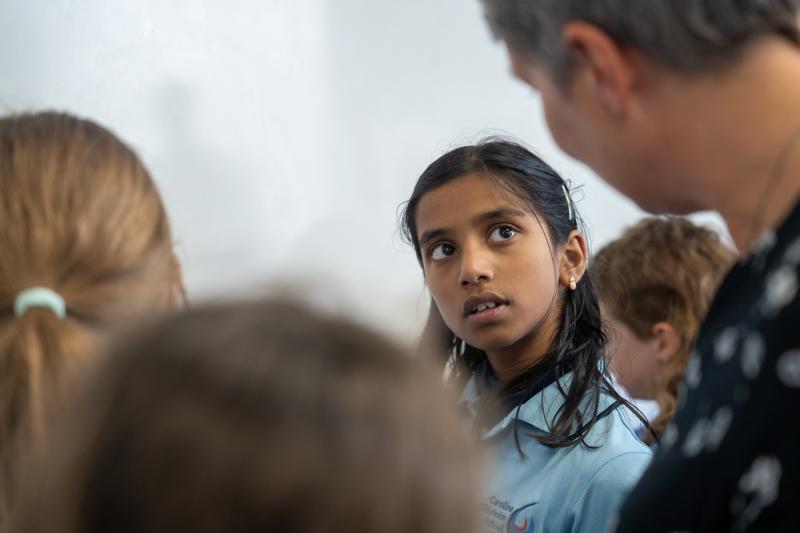
The discourse moves a teacher makes are crucial to ensure that students’ ideas are canvassed and progressively shaped to build communal understanding.
In this case, some of the ways you might support students to reach consensus is by:
- probing and acknowledging new ideas.
- marking interesting, valuable or relevant ideas by repeating them or recording them in the class science journal.
- clarifying a student’s ideas by asking them to re-voice or re-word what they have said. You should allow students an opportunity to do this before you yourself re-cast or paraphrase the idea using the correct terminology.
- canvassing other students’ opinions in relation to ideas by asking questions such as “who agrees…?” or “Who else has evidence to support or contradict …?”
The discourse moves a teacher makes are crucial to ensure that students’ ideas are canvassed and progressively shaped to build communal understanding.
In this case, some of the ways you might support students to reach consensus is by:
- probing and acknowledging new ideas.
- marking interesting, valuable or relevant ideas by repeating them or recording them in the class science journal.
- clarifying a student’s ideas by asking them to re-voice or re-word what they have said. You should allow students an opportunity to do this before you yourself re-cast or paraphrase the idea using the correct terminology.
- canvassing other students’ opinions in relation to ideas by asking questions such as “who agrees…?” or “Who else has evidence to support or contradict …?”
TWLH chart
How can you continue to build a TWLH chart to document students’ metacognitive processes?
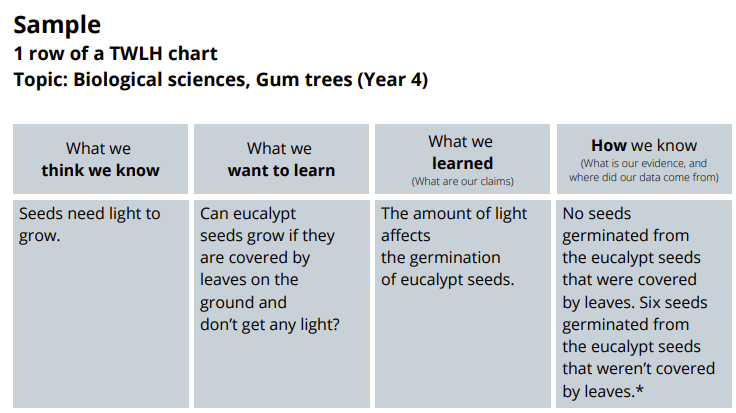
As students undertake the series of investigations that characterise the Inquire phase, they are developing their understanding of the concepts related to the phenomenon being investigated. From this point, the benefits of using a TWLH chart are that it makes learning visible, and that it mirrors the practices of science.
As students share what they have Learned, they are making what is akin to a scientific claim. By stating How they know they have learned something, they are linking to the evidence they have collected that supports their claim.
For example, a student might state that they have learned that light bounces off objects, helping us to see them, and that they know this because when they shone the torch into the peek box, they could see the light hitting the object inside, which helped them to see it, when they couldn't see it before.
The practice of evidence supporting claims in fundamental to science and scientific literacy. Therefore the L and H sections of a TWLH chart should always be discussed together.
As students undertake the series of investigations that characterise the Inquire phase, they are developing their understanding of the concepts related to the phenomenon being investigated. From this point, the benefits of using a TWLH chart are that it makes learning visible, and that it mirrors the practices of science.
As students share what they have Learned, they are making what is akin to a scientific claim. By stating How they know they have learned something, they are linking to the evidence they have collected that supports their claim.
For example, a student might state that they have learned that light bounces off objects, helping us to see them, and that they know this because when they shone the torch into the peek box, they could see the light hitting the object inside, which helped them to see it, when they couldn't see it before.
The practice of evidence supporting claims in fundamental to science and scientific literacy. Therefore the L and H sections of a TWLH chart should always be discussed together.